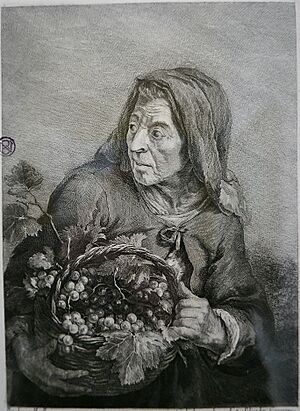Juan Antonio Salvador Carmona facts for kids
Juan Antonio Salvador Carmona was a talented Spanish engraver. He was born on February 7, 1740, in Nava del Rey, Spain. He likely passed away around January 20, 1805, in Madrid. His older brother, Manuel Salvador Carmona, was also a famous engraver. His eldest brother, José Salvador Carmona, was a sculptor.
Contents
Early Life and Artistic Training
Juan Antonio began his art studies in Madrid. His brother Manuel, who was already an artist, taught him. Manuel was learning from their uncle, Luis Salvador Carmona, a sculptor. Juan Antonio first thought he would become a sculptor too. He even helped his uncle create plaster designs for the Pantheon at the Royal Palace of La Granja de San Ildefonso.
In 1758, Juan Antonio applied for a scholarship at the Real Academia de Bellas Artes de San Fernando. However, he was not approved because he was already over the age limit of sixteen.
Improving Engraving Skills
Juan Antonio really wanted to get better at engraving. His brother Manuel was studying in Paris on a scholarship and stayed there longer than expected. So, Juan Antonio found a job with Tomás López, a well-known map engraver. He studied with López for two years. When Manuel returned in 1763, the brothers started working together. This artistic partnership lasted their whole lives.
Artistic Recognition and Important Works
In 1763, Juan Antonio entered an art competition at the Academia. However, another artist, Juan Barcelón, won the award. The next year, Juan Antonio started getting his own art commissions. After building a good reputation, he showed his works at the Academia again in 1770. He was then named a "Supernumerary Academician." This honor was for his amazing engravings of paintings by Bartolomé Esteban Murillo. These works can now be seen at the Calcografía Nacional.
Illustrations and Portraits
Juan Antonio created many illustrations for printers. In 1772, he made drawings for a popular book called The Conspiracy of Catiline. This book was translated by Sebastián Gabriel de Borbón and published by Joaquín Ibarra.
Later, he made engravings of important people. These included portraits of King Charles IV when he was still a prince, and his wife, Maria Luisa of Parma. He also engraved a picture of Charles based on an ivory carving of him on horseback. Another notable work was an "Allegory on Spain," based on a design by Luis Paret.
Following these, he created a series of 41 plates. These plates showed Apostles and important figures of the Church. He also made an allegorical set of the Four Continents, inspired by the artist Luca Giordano. This set was dedicated to Prince Charles. Because of his dedication and skill, when Charles became king in 1788, Juan Antonio was named "Court Engraver."
Later Years and Legacy
A unique autobiography by Juan Antonio, titled Noticias de la vida...hasta aquí, was written in 1795. Not much is known about his very last years. His final known work, from 1802, was an engraving of Saint Lawrence. He dedicated this work to the Marqués de Ariza, who was the King's sommelier (wine steward).
A record at the Royal Palace suggests he died in 1804. However, the historian Manuel Ossorio y Bernard believed he passed away in January 1805. This was shortly before his family sold 107 items from his art collection to the Calcografía Nacional at the Academia.
See also
 In Spanish: Juan Antonio Salvador Carmona para niños
In Spanish: Juan Antonio Salvador Carmona para niños


